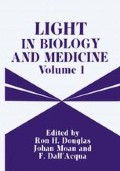Abstract
Long-wavelength phototherapy (PT) using narrow-spectrum fluorescent green lamps has been introduced in 19811,2. The positive results of green lamp PT came unexpected: they were accepted with skepticism as they were in conflict with the current dogma on blue light mechanism of PT action in man3,4. Today, green lamp PT is a well documented procedure5, and several “in vitro” and animal experiments have been reported showing the peculiar characteristics of green light photochemistry of bilirubin (BR)6–10.
Access this chapter
Tax calculation will be finalised at checkout
Purchases are for personal use only
Preview
Unable to display preview. Download preview PDF.
References
C. Vecchi, G. P. Donzelli, M. G. Migliorini, G. Sbrana, and R. Pratesi, New light for phototherapy,The Lancetii:390 (1982).
C. Vecchi, G. P. Donzelli, M. G. Migliorini, and G. Sbrana. Green light phototherapy,Pediatr. Res.17:461 (1983).
J. Ennever, A. F. Mc Donagh, and W. T. Speck, Phototherapy for neonatal jaundice: optimal wavelengths of light,J. Pediatr.103:295 (1984).
L. Ballowitz, F. Hanefeld, and G. Wiese, The Gunn rat: a model for phototherapy,in: “Phototherapy for Neonatal Jaundice”, F. Rubaltelli, and G. Jori, eds., Plenum Press, New York (1984).
C. Vecchi, G. P. Donzelli, G. Sbrana, and R. Pratesi, Phototherapy for neonatal jaundice: clinical equivalence of fluorescent green and “special” blue lamps,J. Pediatr.108:452 (1986).
J. F. Ennever, M. Sobel, A. F. Mc Donagh, and W. T. Speck, Phototherapy for neonatal jaundice: “in vitro” comparison of light sources,Pediatr. Res.18:667 (1984).
J. F. Ennever, Preferential formation of lumirubin by green light,Pediatr. Res.(abstract) 19:218A (1985).
J. F. Ennever, I. Knox, and T. W. Speck, Differences in bilirubin isomer composition in infants treated with green and white light phototherapy,J. Pediatr.109:119 (1986).
A. F. Mc Donagh, and L. A. Palma, Bilirubin photoisomer excretion in Gunn rats: effects of green and blue light,Photochem. Photobiol.45:96S (1987).
G. Agati, A. F. Mc Donagh, R. Pratesi, and F. Fusi, Bilirubin photo-isomerization: wavelength effects,Photochem. Photobiol.45:52S (1987).
J. F. Ennever, J. Knox, and S. C. Denne, Phototherapy for neonatal jaundice: “in vivo” clearance of bilirubin photoproducts,Pediatr. Res.19:205 (1985).
G. Sbrana, M. G. Migliorini, C. Vecchi, and G. P. Donzelli, Laser photolysis of bilirubin,Pediatr. Res.15:1517 (1981).
G. P. Donzelli, M. G. Migliorini, R. Pratesi, G. Sbrana, and C. Vecchi, Laser-oriented search of the optimum light for phototherapy,in: “Phototherapy for Neonatal Jaundice”, F. Rubaltelli, and G. Jori, eds., Plenum Press, New York (1984).
B. S. Rosenstein, and J. M. Ducore, Introduction of DNA strand breaks in normal human fibroblasts exposed to monochromatic UV and visible wavelengths in the 240–546 nm range,Photochem. Photobiol.38:51 (1983).
T. R. C. Sisson, N. Kendall, R. E. Davies, and D. Berger, Factors influencing the effectiveness of phototherapy in neonatal hyper-bilirubinemia, Birth Defects, Original Article Series 6:100 (1970).
S. M. Goldberg, S. Kendall, and T. R. C. Sisson, Photodecomposition of bilirubin “in vivo”,Clinical Res.18:692 (1970).
L. Ballowitz, G. Gentler, J. Krochmann, R. Pannitschka, G. Roemer, and I. Roemer, Phototherapy in Gunn rats,Biol. Neonate31:229 (1977).
F. Ebbesen, Phototherapy with “daylight” and blue light,Danish Med. Bull.22:207 (1975).
K. L. Tan, The nature of the dose-response relationship of phototherapy for neonatal bilirubinemia,J. Pediatr.90:448 (1977).
K. L. Tan, personal communication (1983).
G. Sbrana, G. P. Donzelli, and C. Vecchi, Efficacy of phototherapy in the management of neonatal hyperbilirubinemia with light sources emitting above 500 nm,Pediatrics80:395 (1987).
J. W. Greenberg, J. F. Ennever, and V. Malhotra, Wavelength dependence of the quantum yield for the structural isomerization of bilirubin,Photochem. Photobiol.46:453 (1987).
J. F. Ennever, Clinical and “in vitro” photochemistry of bilirubin,inthis volume.
C. L. Kapoor, C. R. K. Murti, and P. C. Bajpaj, Uptake and release of bilirubin by skin,Biochem. J.136:35 (1973).
V. Malhotra, J. W. Greenberg, L. L. Dum, and J. F. Ennever, Fatty acid enhancement of the quantum yield for the formation of lumi- rubin from bilirubin bound to human albumin,Pediatr. Res.21:530 (1987).
R. R. Anderson, and J. A. Parrish, The optics of human skin,J. Invest. Dermatol.77:13 (1981).
G. Agati, F. Fusi, P. Galvan, A. F. M. Donagh, and R. Pratesi, Quantum yields for laser photocyclization of bilirubin in the presence of human serum albumin. Dependence of quantum yield on excitation wavelength (submitted for publication).
G. Agati, F. Fusi, R. Pratesi, A. F. Mc Donagh (unpublished data).
J. D. Hardy, H. T. Hammell, and D. Murgatroyd, Spectral transmittance and reflectance of excised human skin,J. Appl. Physiol.9:257 (1956).
S. Wan, R. R. Anderson, J. A. Parrish, Analytical modeling for the optical properties of the skin with “in vitro” and “in vivo” applications,Photochem. Photobiol.34:493 (1981).
R. Pratesi, L. Ronchi, G. Cecchi, G. Sbrana, M. G. Migliorini, C. Vecchi, and G. P. Donzelli, Skin optics and phototherapy,Photochem. Photobiol.40:77 (1984).
Author information
Authors and Affiliations
Editor information
Editors and Affiliations
Rights and permissions
Copyright information
© 1988 Plenum Press, New York
About this chapter
Cite this chapter
Donzelli, G.P. (1988). Long-Wavelength Phototherapy. In: Douglas, R.H., Moan, J., Dall’Acqua, F. (eds) Light in Biology and Medicine. Springer, Boston, MA. https://doi.org/10.1007/978-1-4613-0709-9_21
Download citation
DOI: https://doi.org/10.1007/978-1-4613-0709-9_21
Publisher Name: Springer, Boston, MA
Print ISBN: 978-1-4612-8043-9
Online ISBN: 978-1-4613-0709-9
eBook Packages: Springer Book Archive

